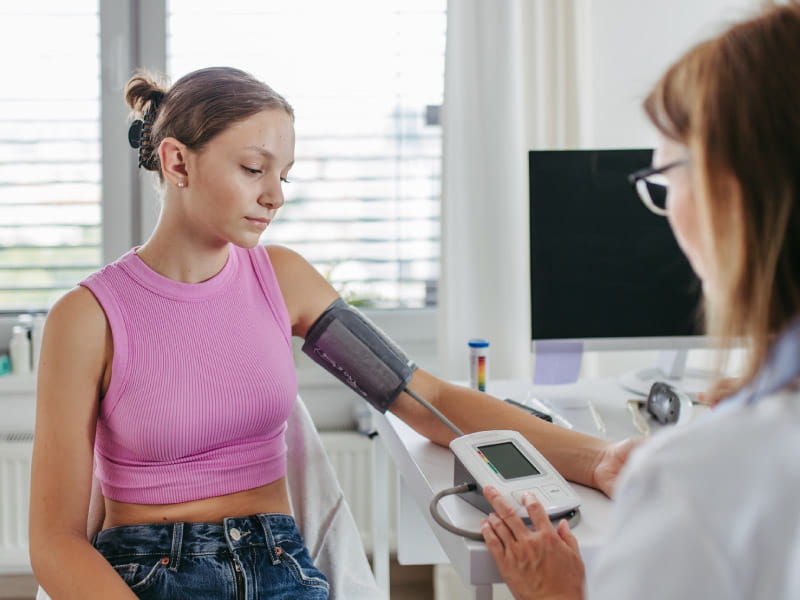1 in 7 kids in US may have blood pressure that's higher than normal
By Laura Williamson, American Heart Association News

About 14% of children and teens in the U.S. either have high blood pressure or are headed toward it, according to preliminary new research that suggests a need for greater prevention efforts earlier in life.
"Hypertension can begin in childhood, and it's a risk factor for heart disease and stroke," said lead researcher Dr. Ahlia Sekkarie, an epidemiologist in the division for heart disease and stroke prevention at the Centers for Disease Control and Prevention. "It's important to monitor blood pressure in youth, because young people with heart disease and stroke risk factors are more likely to have cardiovascular disease as adults.
"Childhood is a great time to learn healthy habits to reduce these risks," she said.
Sekkarie will present the findings Friday at the American Heart Association's Hypertension Scientific Sessions in Chicago. The research is considered preliminary until full results are published in a peer-reviewed journal.
Nearly half of adults in the U.S. have high blood pressure, which over time can lead to damaged arteries and plaque buildup that causes heart attacks, strokes and other problems. Prior studies have found links between high blood pressure in childhood and cardiovascular disease as an adult.
In 2017, the American Academy of Pediatrics updated its guidelines to revise blood pressure thresholds in kids up to 17 years old. Since then, estimates of how common blood pressure problems are in children and teens have been lacking.
For children under 13, high blood pressure is diagnosed when three or more readings are at or above the 95th percentile, meaning 95% of other kids of the same age, sex and height have a lower blood pressure. Blood pressure is considered elevated when measurements fall within the 90th to 94th percentile.
Hypertension is diagnosed in teenagers as it is in adults. The systolic blood pressure – the top number – must be at least 130 mmHg, or the diastolic pressure – the bottom number – must be 80 mmHg or above. Elevated blood pressure is a systolic reading of 120 mmHg to 129 mmHg and a diastolic reading of less than 80 mmHg.
Drawing from the 2017 to 2020 National Health and Nutrition Examination Survey, Sekkarie and her team analyzed blood pressure and body mass index data for 2,600 youth ages 8 to 19. For those 13 and older, they used both percentile-based and adult blood pressure thresholds to compare the two.
Overall, 8.7% had elevated blood pressure and 5.4% had high blood pressure. Blood pressure measurements were higher among boys than girls and rose with age. Youth with severe obesity had the highest prevalence of high blood pressure, and Hispanic youth had the lowest rate of elevated blood pressure. For teens, using percentile-based instead of adult thresholds did not dramatically change the results.
High blood pressure can be managed or prevented by maintaining a healthy weight, eating a healthy diet high in fruits and vegetables and low in saturated fats, limiting sodium, not smoking, limiting alcohol and staying physically active.
"What surprises me is how many families and primary care providers don't recognize that high blood pressure can start in childhood, especially in adolescence, and that it's related to poor lifestyle and overweight and obesity," said Dr. Elaine Urbina, director of preventive cardiology at the Cincinnati Children's Hospital Heart Institute in Ohio. Urbina was not involved in the new research but co-authored a recent AHA report about high blood pressure in childhood.
While the study did not look at why pediatric hypertension rates were high, Sekkarie said cardiovascular risk factors such as obesity – which affects 1 in 5 children and adolescents in the U.S. – certainly could be at play.
Some health care professionals, she said, might not follow AAP guidelines to screen for high blood pressure yearly starting at age 3, allowing blood pressure to climb without steps being taken to control it. Also, as children grow older and transition away from pediatric care, they might not immediately enter the care of a primary care physician and may miss regular screenings.
"Many adolescents fall through the cracks," Sekkarie said.
The findings highlight the need for greater attention to prevention efforts for kids, said Urbina, who also is a professor in the department of pediatrics at the University of Cincinnati.
"The rate of hypertension has to be addressed. Otherwise, we're going to have people having heart attacks and strokes at a young age," she said.





